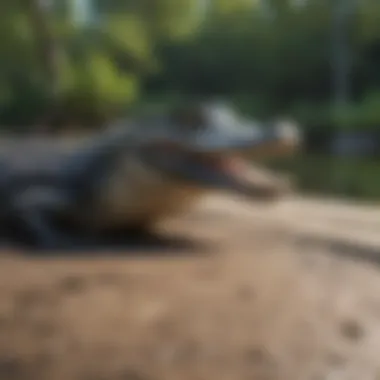Understanding Alligators in Myrtle Beach: A Comprehensive Guide


Intro
Myrtle Beach, a popular vacation destination, is not just known for its stunning coastline and entertainment options but also for its unique wildlife. Among the notable fauna, alligators hold a significant presence in this region. Understanding their role within the ecosystem sheds light on the delicate balance of nature and human interaction. This article aims to explore various aspects related to alligators, including habitat, behavior, and the ecological impact they have in Myrtle Beach.
Fascinating Facts About the Animal
Unique Characteristics
Alligators are distinct reptiles, easily recognized by their powerful jaws, rough skin, and mass of muscle. These creatures can reach impressive lengths, with males averaging between 11 to 15 feet. Their coloration, usually dark gray to black with a lighter underside, aids in camouflaging within their natural habitats. Notably, alligators possess a unique feature — their ability to regulate body temperature, which is essential for their survival in varying climates.
Extraordinary Abilities
Alligators are remarkable predators. They can remain submerged, with only their nostrils above the water, for up to two hours while stalking prey. Their strong tails allow swift movement through water. When it comes to hunting, they utilize a method called the
Preface to Alligators in Myrtle Beach
Alligators are a crucial part of the ecosystem in Myrtle Beach. They contribute to the balance of local wildlife and play a significant role in the health of their habitat. This article explores their presence, behavior, and interactions with humans, emphasizing the need for awareness and respect for these creatures.
Overview of Alligator Species
In Myrtle Beach, the primary species is the American alligator, known scientifically as Alligator mississippiensis. This species is distinct for its robust body, powerful jaws, and a unique pattern of scales. Adult alligators can reach lengths of up to 13 feet, although averages are typically around 8 to 10 feet. The American alligator plays an integral role in its habitat, as it helps maintain the populations of other species. This predatory reptile consumes fish, amphibians, and small mammals. By regulating these populations, alligators ensure ecological balance, since overpopulation of certain species can lead to habitat degradation.
Significance of Myrtle Beach Environment
The environmental landscape of Myrtle Beach is a mix of subtropical wetlands, estuarine systems, and freshwater rivers. These environments provide excellent habitats for alligators. The wetlands, in particular, serve as breeding grounds. The abundant vegetation offers cover and nesting sites.
Moreover, Myrtle Beach's coastal ecosystem is vital for biodiversity. It attracts various species of birds and fish, which alligators feed on, sustaining their role as apex predators. The health of this ecosystem reflects directly on the alligator's population, as well as the overall environmental quality in the region. This interdependence highlights the significance of understanding alligator behavior and their habitat requirements.
Overall, acknowledging the presence and importance of alligators provides insights into managing local ecosystems sustainability.
Habitat of Alligators in Myrtle Beach
The habitat of alligators in Myrtle Beach is a key topic in understanding their role in the local ecosystem. This section discusses various aspects of their living environments and the challenges they face. Knowing their habitat preferences helps residents and visitors appreciate the delicate balance between nature and urbanization. It highlights the need for informed actions that can lead to the conservation of these reptiles.
Preferred Environments
Alligators thrive in various environments, specifically in warm, freshwater areas. In Myrtle Beach, they are often found in swamps, marshes, and lakes. These environments provide necessary resources for survival. Water sources not only serve as homes but also as hunting grounds. This reptile prefers areas that offer plenty of vegetation, as it provides cover for stalking prey.


Common habitats include:
- Freshwater lakes: These bodies of water can be rich in fish and small mammals, serving as a primary food source.
- Marshes: Marshlands are ideal nesting sites and offer diverse food sources.
- Canals: Man-made canals can also attract alligators, providing a suitable environment in urban settings.
Alligators are ectothermic, meaning they rely on external heat sources. This feature is significant in coastal areas like Myrtle Beach, where the climate largely influences their activities. They bask in the sun to regulate their body temperature.
Impact of Urban Development
Urban development has greatly influenced alligator habitats in Myrtle Beach. As the area has expanded, many wetlands have been altered or destroyed. This loss of habitat can have dire effects on alligator populations.
Key consequences of urbanization include:
- Loss of Nesting Sites: Alligators use wetlands and grasslands for nesting. Losing these areas threatens their reproductive abilities.
- Reduced Prey Availability: Urban sprawl can diminish fish and other food sources. This leads to competition for remaining resources.
- Increased Human Interaction: As humans encroach into alligator territory, there are heightened chances for conflicts. Alligators may venture closer to populated areas in search of food.
Adapting to a changing environment is crucial for alligator survival. They might change their behaviors in response to urban factors, often leading to more sightings in less natural settings.
Understanding these challenges emphasizes the need for conservation efforts. Protecting and restoring natural habitats is key in ensuring the survival of alligators in Myrtle Beach.
Behavior and Ecology of Alligators
Behavior and ecology are central to understanding alligators in Myrtle Beach. These aspects of alligator life are essential for grasping their role within the ecosystem. Knowing their behavior helps residents and tourists alike to interact more safely with these reptiles.
Feeding Habits
Alligators are opportunistic feeders. Their diet varies with the seasons and availability of food. They consume a wide range of prey including fish, birds, and small mammals. In Myrtle Beach, they often hunt in shallow waters, taking advantage of the local fish population. Their ability to stay submerged for long periods allows them to ambush unsuspecting prey.
During warmer months, alligators can be seen basking in the sun. This behavior promotes digestion. Understanding what alligators eat is important for recognizing their presence, as well as appreciating their role in controlling local populations of prey species.
Reproduction and Lifespan
Alligator reproduction happens primarily in spring and summer. Mating rituals can be quite complex, with males engaging in vocalizations to attract females. A female lays between 20 to 50 eggs in a nest made of vegetation, which provides insulation and camouflage. Incubation lasts about 65 days.
Juvenile alligators grow rapidly, reaching over a foot within their first year. They live about 35 to 50 years in the wild, but can exceed that in captivity. This longevity demands a focus on their reproductive behavior. It is critical for maintaining their populations, especially in areas affected by human activity.
Social Structures
Alligators exhibit a hierarchical social structure. Larger males often dominate smaller individuals, establishing territory where they have exclusive rights to resources. Despite appearances, they can have complex interactions. They communicate through body language, vocalizations, and even chemical signals.
Social structures play a role in their breeding success and resource allocation. Males will often be seen competing for dominance, particularly during the mating season. Recognizing these structures aids in understanding alligator behavior, which is crucial for managing human-alligator interactions effectively.


Understanding the behavior and ecology of alligators not only enriches our knowledge of their life cycle but also highlights the importance of coexistence in Myrtle Beach’s unique environment.
Human-Alligator Interactions
Human-alligator interactions present a vital area of study in understanding how these reptiles coexist with people in Myrtle Beach. Alligators, being apex predators, play an important role in the local ecosystem, and their presence can affect human activities. Recognizing interactions helps in various ways. It informs safety measures and promotes better coexistence between humans and wildlife. Understanding this topic is critical for residents, tourists, and local wildlife authorities to ensure a balanced approach to urban planning and conservation efforts.
Reported Sightings and Incidents
Alligator sightings in Myrtle Beach are common, especially in certain seasons. Sightings often occur near rivers, ponds, and swamps within the area. There have been occasional reports of alligators venturing into residential neighborhoods or golf courses. These encounters can become problematic if not managed properly. For instance, some residents have had close encounters while walking pets near water bodies.
Safety incidents, while relatively rare, do happen. Instances of aggressive behavior are often linked to perceived threats to their territory or if the alligator feels cornered. For example, a few years ago, an incident involved an alligator entering a busy pool area, leading to a swift response from local wildlife control.
Alligator management programs have been established to track sightings and ensure that potentially dangerous animals are relocated safely away from densely populated areas.
Behavioral Adaptation to Human Proximity
Alligators are naturally adaptive animals. As human populations expand, these reptiles often alter their behaviors to coexist. They become more active during dusk and dawn, times when human activity decreases. This change allows them to hunt without the immediate threat posed by humans. Additionally, urban areas provide new opportunities for shelter and food, such as discarded food from picnic areas or parks.
Research indicates that alligators in populated areas tend to become less fearful of humans over time. This behavioral adaptation raises important concerns for safety. A food reward system can develop when humans feed alligators, leading them to associate people with food. This behavior is dangerous, as alligators may approach humans more frequently in search of meals.
To mitigate these concerns, education and awareness programs emphasize that feeding wildlife is prohibited. Additionally, local authorities encourage reports of frequent sightings to better understand patterns of alligator movement. Strategies to minimize risky encounters include posting warnings near water bodies and ensuring proper waste disposal to reduce food sources.
Safety Measures for Residents and Tourists
Understanding Alligator Behavior
To effectively ensure safety, it is essential to comprehend alligator behavior. Alligators are most active at dawn and dusk. During these times, their hunting instincts come alive, so extra caution is necessary when near water bodies.
Their natural tendency is to avoid humans, but they can become aggressive if threatened or if a human approaches too closely. Understanding these behaviors helps in predicting their movements and maintaining a safe distance.
Here are some key points to note about alligator behavior:
- Territorial Nature: Alligators can be territorial, especially during mating seasons. Avoid venturing too close to nests or areas where they are basking in the sun.
- Speed and Agility: Despite their bulk, alligators can move quickly, both in water and on land. Never underestimate their ability to chase down potential threats or prey.
- Diet: They are opportunistic feeders, meaning they might be attracted to areas with ample food sources. Secure trash bins and avoid leaving pet food outside to minimize attracting them.
"Understanding alligator behavior is key to preventing dangerous encounters."
Precautions When Visiting Natural Areas


For those visiting natural habitats in Myrtle Beach, certain precautions can greatly reduce the likelihood of negative interactions with alligators. When in natural areas, take heed of the following recommendations:
- Stay on Designated Paths: When exploring wetland areas or parks, stick to marked trails. This helps to avoid inadvertently disturbing alligator habitats.
- Keep a Safe Distance: If you spot an alligator, maintain a distance of at least 30 feet. Do not attempt to feed or provoke them.
- Do Not Swim in Unfamiliar Waters: Alligator presence is common in many local water bodies. Swimming in areas without clear signage can pose significant risk. Seek out designated swimming zones only.
- Supervise Children and Pets: Always keep a close eye on children and pets near water. Leashing pets can prevent accidental encounters.
By following these precautions, residents and tourists can enjoy Myrtle Beach's natural landscape while minimizing risks associated with alligator encounters. Safety is paramount, and understanding these measures can enhance the experience of enjoying the diverse ecosystem without jeopardizing personal safety.
Conservation Efforts in Myrtle Beach
Conservation efforts in Myrtle Beach play a crucial role in maintaining the delicate balance between human activity and the natural habitat of alligators. Understanding these initiatives not only highlights the efforts made to protect this unique species but also emphasizes the ecological importance of alligators within the region. These conservation actions foster a healthier ecosystem, benefitting both wildlife and the local community.
Role of Local Organizations
Local organizations are pivotal in the conservation landscape of Myrtle Beach. Several groups are dedicated to protecting wildlife and their habitats. For instance, the South Carolina Department of Natural Resources works to manage the alligator population, offering guidelines and regulations for their protection.
These organizations often involve the public through volunteer programs and educational workshops. Here are a few key contributions:
- Habitat Restoration: Local organizations engage in efforts to restore wetland areas where alligators reside. Restoring these habitats ensures that alligator populations can thrive.
- Monitoring Populations: Regular monitoring of alligator populations helps assess their health and numbers. This data informs management strategies and conservation policies.
- Research Support: They often support research initiatives focusing on alligator behavior and ecology, which can guide future conservation efforts.
Such contributions are vital for understanding and maintaining the role of alligators in the ecosystem, promoting biodiversity in Myrtle Beach.
Community Education Initiatives
Community education initiatives are essential for fostering a culture of coexistence between residents and alligators. These programs focus on informing the public about the ecological significance of alligators and safe ways to interact with these reptiles.
Key aspects of these education initiatives include:
- Workshops and Seminars: These events educate the public about alligator behavior and the importance of preserving their habitats. They often cover topics such as safety practices and how to respond to alligator encounters.
- Informative Signage: Installing signs in popular outdoor areas helps raise awareness about alligator presence and advises on safe practices around lakes and ponds.
- School Programs: Engaging with local schools provides younger generations with knowledge about alligators and their ecological role, fostering respect for wildlife.
Education builds a foundation for understanding, reducing conflicts, and promoting responsible behavior in areas where alligators are present.
By equipping the community with the necessary information, these initiatives contribute significantly to the conservation efforts in Myrtle Beach. Thus, a well-informed public can actively participate in preserving both alligators and their habitats.
Epilogue
Summary of Insights
The exploration of alligators in Myrtle Beach reveals their complex role in the regional ecosystem. Understanding their behavior, habitat, and interactions with humans is essential for coexistence. Alligators are apex predators, significantly influencing the populations of other species in freshwater habitats. This balance showcases their importance in promoting biodiversity. As urban development expands, it becomes crucial to monitor and manage alligator populations effectively. The insights shared throughout this article provide a holistic view of the significance of alligators in Myrtle Beach.
Future Considerations for Wildlife Management
Looking to the future, wildlife management in Myrtle Beach must focus on several critical areas. First is the need for effective habitat conservation strategies. Preserving wetland areas where alligators thrive is vital. The integration of urban development and conservation efforts can help achieve this goal. Secondly, ongoing community education plays a significant role. Residents and tourists must be informed about the behaviors and risks associated with alligators.
Moreover, research should continue to collect data on alligator populations and health. It will inform policies that ensure their survival alongside humans. Collaborative efforts among local organizations, wildlife biologists, and the community will be essential to address these challenges. This proactive approach will lead to improved coexistence between humans and alligators.
Balancing human activities with wildlife preservation is pivotal for the ecosystem's health.







